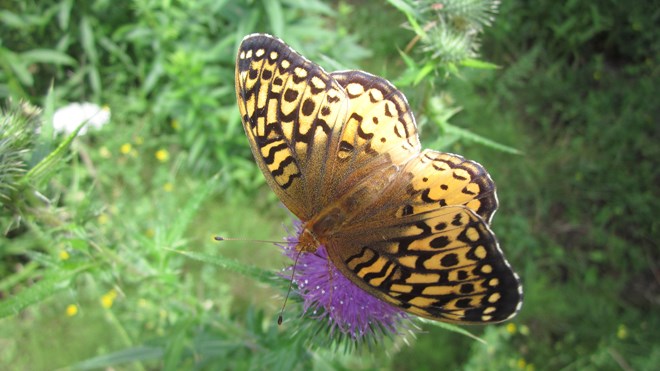It was inching towards another destination. Hind end secure, front end pushed forward. Stop. Front end secure, hind end dragged forward, stop, and then repeat.
At this rate it should be able to find a new location in a relatively short time. The light brown colouration of its body helps it blend in perfectly with the red brown substrate that it has travelled along.
As long as the twig moves gently in the breeze and the leaves tremble in the light wind, the predatory eyes of birds may very well miss its movements.
There are all sorts of caterpillars in the local white birch and trembling aspen that feed on the leaves. Summer is hot, leaves abundant and activity rampant.
The larvae of the moths and butterflies have an agenda to follow.
They must feed heavily, grow and form their protective pupae (moths) or chrysalides (butterflies) so that they can complete the life cycle and become adults.
Caterpillars range in size from the very minute, particularly when they first hatch from the egg, to the very large as they grow. Sudbury is unique in its abundance of trembling aspen, white birch and red maple.
The large giant silk moths such as the beautiful green Luna, tan and eyed Polyphemus and brown and eyed Cecropia emerge from over wintering cocoons in late May and June. They lay eggs in a short adult stage.
In July and early August you might be able to find the next generation, three-inch-long, half-inch-thick green caterpillars nestled in amongst the leaves. Because they are so large, you can sometimes find the frass, their abdominal leavings, on the ground beneath where they are hiding. Watch where you sit!
July is a great month for keeping your eyes open for the bright-coloured butterflies. A great spangled fritillary lands on a Queen Anne’s lace or flowering Canada thistle.
Watch closely as the mouth parts called the proboscis uncoils from the head region and probes into the flowers for nectar. The bright orange and black Monarch and its mimic, the smaller Viceroy, can be seen visiting composite flowers for nectar as well.
Monarchs will target milkweeds to lay their eggs on but the Viceroy is less fussy and will choose willows and poplar as a food source for the young. Viceroys are more common in our area.
Some butterflies will overwinter as larvae, some as cocoons and some as adults. The first butterflies in spring such as the morning cloak, and Compton’s tortoiseshell are often the overwintering adults that have found a crack or niche to stay safe during the cold months.
Perhaps your outdoor shed served this purpose last year. These butterflies are often dull coloured and rough looking due to the overwintering period.
Later versions of the same species will look bright and flashy as they have completed a life cycle without seeing the winter.
There are also some very unusual life cycles. Sarah from Junction Creek Stewardship Group found a harvester butterfly larvae recently. What is so interesting about a harvester butterfly?
The larvae are small and well camouflaged and actually live in a colony of another type of insect called the white wholly aphid. The caterpillar feeds on the aphids and uses their body parts for camouflage. The adults will feed on the “honeydew” excreted by aphids.
See how many butterflies and moths you might have in your backyard and flower garden this summer. If you take the time to look you may quickly get fascinated by all that is out there.
Chris Blomme is an executive member of the Sudbury Ornithological Society and works with animals at Laurentian University. Have a question for Chris? Send it [email protected].
